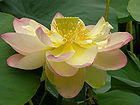- Mahāratnakūṭa Sūtra
-
Lands India • China • Japan
Vietnam • Korea
Singapore • Taiwan
Tibet • Bhutan • Nepal
Mongolia • United StatesDoctrine Bodhisattva • Śīla
Samādhi • Prajñā
Śunyatā • TrikāyaMahāyāna Sūtras Prajñāpāramitā Sūtras
Lotus Sūtra
Nirvāṇa Sūtra
Saṃdhinirmocana Sūtra
Avataṃsaka Sūtra
Śūraṅgama SūtraMahāyāna Schools Mādhyamaka
Yogācāra
Esoteric Buddhism
Pure Land • Zen
Tiantai • Nichiren
The Mahāratnakūṭa Sūtra (Sanskrit; traditional Chinese: 大寶積經; simplified Chinese: 大宝积经; pinyin: dàbǎojī jīng) is an ancient collection of Mahāyāna Buddhist sūtras.Contents
Overview
The Mahāratnakūṭa Sūtra contains 49 texts of varying length, which are termed "assemblies" by tradition. This text was translated into Chinese by Bodhiruci in the 8th century, between 707 and 713 CE (Taishō Tripiṭaka 310). This collection includes the Śrīmālādevī Siṃhanāda Sūtra, the Longer Sukhāvatīvyūha Sutra, the Akṣobhyavyūha Sūtra, a long text called the Bodhisattvapiṭaka, and others.[1] The Ratnakūṭa collection totals 49 Mahāyāna sūtras, divided into 120 fascicles in the Chinese translation.[2] Garma C.C. Chang, who has translated a number of sūtras from the Mahāratnakūṭa from Chinese into English, summarizes the breadth and variety of texts contained in this collection:[3]
We have found this work to contain a broad coverage of various subjects. The topics discussed range from the monastic precepts (Vinaya) to intuitive wisdom (prajñā), from good deportment to the manifestation of the Tathāgata's light, from illusion (māyā) to ingenuity (upāya) to the nature of consciousness and the Pure Land practice. It can perhaps be called a small encyclopedia of Mahāyāna Buddhism, which should be useful to general readers as well as to scholars.History
According to the Theravādin Nikāyasaṅgraha, the Ratnakūṭa Sūtra was composed by the "Andhakas", meaning the Mahāsāṃghika Caitika schools of the Āndhra region.[4][5]
Further reading
- Garma C.C. Chang (tr). A Treasury of Mahāyāna Sūtras: Selections from the Mahāratnakūṭa Sūtra. 1983. ISBN 978-0271034287
References
- ^ Sangharakshita. The Eternal Legacy: An Introduction to the Canonical Literature of Buddhism. 2006. p. 168
- ^ "The Korean Buddhist Canon: A Descriptive Catalog (T 310)". http://www.acmuller.net/descriptive_catalogue/files/k0022.html.
- ^ Sangharakshita. The Eternal Legacy: An Introduction to the Canonical Literature of Buddhism. 2006. p. 168
- ^ Adikaram, E.W. Early History of Buddhism in Ceylon. 1953. p. 100
- ^ Paul, Diana. The Buddhist Feminine Ideal. 1980. p. 12
Categories:
Wikimedia Foundation. 2010.

